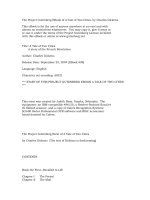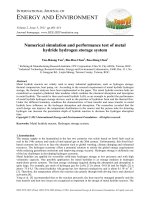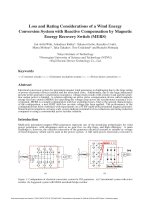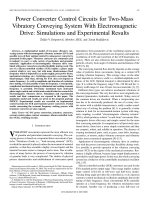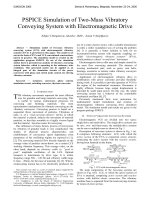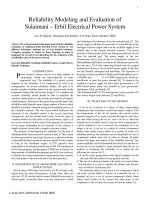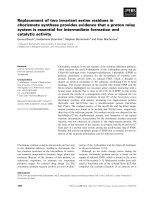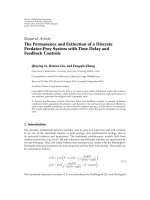PSPICE simulation of two mass vibratory conveying system with electromagnetic drive
Bạn đang xem bản rút gọn của tài liệu. Xem và tải ngay bản đầy đủ của tài liệu tại đây (298.11 KB, 4 trang )
EUROCON 2005 Serbia & Montenegro, Belgrade, November 22-24, 2005
Abstract — Simulation model of two-mass vibratory
conveying system (VCS) with electromagnetic vibratory
actuator (EVA) is presented in this paper. The model is set
out on the
basis of EVA and VCS conventional constructions,
known in practice. The simulation model is created on the
application program PSPICE. By use of the simulation
model, there is presented an analysis of vibratory conveying
system behavior, which is operating in the stationary state
conditions. This generated model can be applied as an
integral part of the simulation circuits of the power
converters with phase and switch mode control, for driving
vibratory actuator.
Keywords — Actuators, conveyors, phase control,
simulation circuit, switching converter, thyristor converter.
I. I
NTRODUCTION
HE vibratory movements represent the most efficient
way for granular and lump materials conveying. This
is useful in various technological processes for
conveying and finishing materials. The most
representative mechanisms for vibratory conveying are the
vibratory conveyors. Conveying process is based on a
sequential throw movement of particles. Vibrations of
tank, i.e. of a “load-carrying element” (LCE), in which
the material is placed, induces the movement of material
particles, so that they resemble to a highly viscous liquid
and the material becomes easier for conveying.
Due influences of many factors, process of conveyance
by vibration of granular loads is very complicated. The
studies of physical process characteristics and
establishment of conveyance speed dependence from
parameters of the oscillating regime are exposed in [1],
[2]. The conveying material flow directly depends on the
average value of particles micro-throw, on a certain LCE
working vibration frequency. This average value, on the
other hand, depends on vibratory width i.e. “peak to
peak” amplitude oscillation, of the LCE. Optimal
transport is determinate by drive type. It is within
frequency range 5Hz – 120 Hz and vibratory width range
0.1mm – 20mm, for the most of materials [2], [3]. When a
reciprocating motion has to be electrically produced, the
This research was done as a part of research project supported by
Serbian Ministry of Science under grant 006610.
Z.V.Despotovic is with the Mihajlo Pupin Institute, Volgina 15, 11050
Belgrade, Serbia & Montenegro (phone: 381-11-2771-024; fax:
381-11-2776-583; e-mail:
Z.V. Stojiljkovic is with the School of Electrical Engineering,
University of Belgrade, Bulevar kralja Aleksandra 73, 11120 Belgrade,
Serbia & Montenegro; (e-mail: ).
use of a rotary electric motor, with a suitable transmission
is really a rather roundabout way of solving the problem
[4]. It is generally a better solution to look for an
incremental-motion system with magnetic coupling, so-
called “electromagnetic vibratory actuator” (EVA),
which produces a direct “to-and-from” movement.
Electromagnetic drives offer easy and simple control for
the mass flow conveying materials. The absence of
wearing mechanical part, such as gears, cam belts,
bearings, eccentrics or motors, make vibratory conveyors
as most economical equipment [5].
Application of electromagnetic vibratory drive in
combination with power converter provides flexibility
during work. It is possible to provide operation of VCS in
the region of the mechanical resonance. Resonance is
highly efficient, because large output displacement is
provided by small input power. On this way, the whole
conveying system has a behavior of the controllable
mechanical oscillator [6], [7].
Previously mentioned facts were motivation for
mathematical model formulation and creation of
electromagnetic vibratory conveying drive simulation
model. The simulation model and results are given in the
program package PSPICE.
II. T
YPES OF
V
IBRATORY
C
ONVEYING
S
YSTEMS
Electromagnetic VCS are divided into two types:
single-drive and multi-drive. The single-drive systems can
be one-, two- and three-mass; the multiple-drive systems
can be one-or multiple-mass as shown in Fig. 1.
Description of one-mass system is shown in Fig. 1 (a).
It comprises following elements: LCE, with which the
active section of the EVA is connected, elastic element,
connecting the active section with the reactive section,
having been fastened on the frame.
Fig. 1. VCS with electromagnetic drives
The main components of the two-mass systems are
shown in Fig. 1(b): LCE, to which the active section of
EVA is attached, comprising active section and reactive
section, with built-in elastic connection. The vibratory
machine base is separated from the load-carrying structure
by means of plate springs.
PSPICE Simulation of Two-Mass Vibratory
Conveying System with Electromagnetic Drive
Zeljko V.Despotovic, Member, IEEE , Zoran V.Stojiljkovic
T
A special drive, comprising two identical actuators,
which oscillate in mutually perpendicular directions like in
Fig. 1(c), is used for elliptical oscillation. The multiple-
drive multiple-mass system as shown in Fig.1 (d), has a
LCE on which a number of identical actuators with elastic
connections are tied.
III. M
ATHEMATICAL
M
ODEL OF
EVA
All main types of vibratory actuators can be
considered as single- or double-stroke construction. Fig. 2
(with detailed presentation) shows the most common,
single-stroke constructions. There is an electromagnet,
whose armature is attracted in one direction, while the
reverse stroke is completed by restoring elastic forces.
Fig. 2. Construction of the conventional EVA
Mathematical model of EVA, exposed in [8], is based
on presentation from Fig. 2. Electromagnet is energized
from an AC source. Reactive section is mounted on elastic
system of springs. During each half period when the
maximum value of the current is reached the armature is
attracted, and at a small current value it is repelled as
result of the restoring elastic forces in springs. Therefore,
vibratory frequency is double frequency of the power
supply. These reactive vibrators can also operate on
interrupted pulsating (DC) current. Their frequency in this
case depends on the pulse frequency of the DC.
Mechanical force, which is consequence of this current
and created by electromechanical conversion in EVA, is
transmitted through the springs to the LCE.
Dynamic differential equations for motion of the EVA
are described in definitely form [8]:
2
2
)xdD(
ia
xkxxm
−+
⋅
=⋅+⋅+
β
(1)
)t(u
)xdD(
xia
i)RR(
dt
di
xdD
a
cs
=
−+
⋅⋅
+++⋅
−+
2
22
(2)
The first term is voltage that has been induced from
current change in the circuit of the coil. Inductance of the
circuit is the function of the inductor’s position. The
second term presents voltage drop on the equivalent
resistance. The third term is, in fact, induced electromotive
force, which is a consequence of exertion of the
mechanical sub-system on the electromagnetic sub-
system.
IV. M
ATHEMATICAL
M
ODEL OF
T
HE
VCS
Description of one type of two-mass electromagnetic
vibratory conveyor is shown in Fig. 3. Flexible elements,
by which the LCE with material is supported, are
composed of several leaf springs i.e. plate springs. These
elements are rigidly connected with the LCE on their one
side; while on the other side, they are fitted to the base of
the machine and sloped down under define angle.
Fig. 3. Two-mass vibratory conveyor with plate springs
Referent direction of x-axis is normal to direction of the
flexible elements. We will assume that oscillations are
made under exciting electromagnetic force f
(t)
in x-
direction. The system is started with oscillations from the
static equilibrium state in which the already exists between
gravitational and spring forces. From above assumption,
this construction is a system with two degrees of freedom,
which is shown in Fig. 4.
Fig. 4. Model of the VCS for analysis
Model will be analyzed in a way that the mass of EVA
reactive section is presented by m
1
, while mass m
2
constitutes a sum of masses (LCE, conveying material and
the active section of EVA). The mass m
2
is a variable
parameter within the system, because mass of the
conveying material is varied under real conditions.
Displacements of both masses m
1
and m
2
within an
oscillatory system are described as x
1
and x
2
, respectively.
Equivalent stiffness of springs within EVA is denoted
as k
1
, while equivalent stiffness of plate springs is denoted
as k
2
. Coefficient β
1
describes mechanical losses and
damping of the reactive part in EVA, while β
2
is
equivalent damping coefficient within transporting system
(LCE with material). In order to achieve dynamic model
of this system, we will divide the system into two sub-
systems, shown in Fig. 5.
Fig. 5. Simplification of the VCS
We observe mass m
1
and its affect on the rest of the
system by force
)]xx()xx[(k)xx(
2021011211
−−−⋅−−⋅−
β
, like in
Fig. 5(a). Differential equation in this case is formulated
as:
).t(f)]xx(
)xx[(k)xx()cosgx(m
+−−
−−−−−=−
202
101121111
βα
(3)
In the state of static equilibrium:
1012011
xkxkcosgm
⋅−⋅=⋅α
,
000
21
=−
)(x)(x
,
00
=
)(f
, so equation
(3) becomes:
.)t(fxkxkxxm
+⋅+⋅−−=
21111111
β
(4)
We observe mass m
2
and its affect on the rest of the
system with force,
)]xx()xx[(k)xx(
2021011211
−−−⋅+−⋅
β
, like in
Fig. 5(b). Differential equation in this case is described as:
)xx()]xx(xx[k
)xx(kx)cosgx(m
2112021011
20222222
−+−−−+
+−−−=−
β
βα
(5)
In the state of equilibrium,
10120122
xkx)kk(cosgm ⋅−⋅+=⋅−
α
and
000
21
=−
)(x)(x
, so the above equation becomes:
)xx(xkxkxkxxm
2112111222222
−⋅+−+−−=ββ
(6)
From electrical equation (1) for EVA (by
substituting
21
xxx
−→
;
21
xxx
−→
) and from derived equations
(4
)
and (6), which are related to previously presented model
of the conveying drive, we conclude that dynamical
equations of the VCS in their final form are:
()
)t(fxxk)xx(xm
=−⋅+−⋅+
21121111
β
(7)
0
211112212222
=−⋅−−+++ )xx(xkx)kk(xxm
ββ
(8)
)t(u
)]xx(dD[
)xx(ia
i)RR(
dt
di
)xx(dD
a
cs
=
−−+
−⋅⋅
+
+++⋅
−−+
2
21
21
21
2
2
(9)
2
21
2
)]xx(dD[
qa
)t(f
−−+
⋅
=
(10)
iq =
(11)
The whole system is described by three differential
equations. Differential equations (7) and (8) describe
mechanical behavior of the system under time-variable
exciting electromagnetic force f
(t),
which is a consequence
of coil current i
(t)
. The third equation is (9), for coil
electrical equilibrium.
V. S
IMULATION
C
IRCUIT
Simulation circuit of VCS is created on the basis of
previously derived differential equations. Functional
diagram is shown in Fig. 6, upon which the simulation
model is based. Mechanical quantities are shown with
equivalent electric quantities according table of
electromechanical analogs for inverse system [9].
Fig. 6. Simulation circuit of VCS
Simulation model is generated in PSPICE and sub-
circuit is formed for application within different
simulation schemes, when analyzing various types of
power converters for electromagnetic vibratory drive.
VI. S
IMULATION
R
ESULTS
This section represents simulation results for cases of
phase angle control and switch-mode current control. We
have taken parameters of the actuator and vibratory
system, which are usually occur in practice. Electrical and
mechanical parameters of EVA are given in Table I.
Mechanical parameters of the conveyor are given in Table
II.
Load mass, which is oscillating, is m
2
=98,5kg, so that the
mechanical natural frequency f
res
of the system is equal to
mains (AC source) frequency f =50Hz.
A. Phase control
Fig. 7. Simulation scheme of power converter with phase
control
Simulation circuit with phase angle control of EVA coil
is given in Fig. 7. Power thyristor is simulated as voltage-
controlled switch S, with diode D in series. Conducting
moment of the switch S is determined by control voltage,
synchronized with the moment of mains voltage zero-
cross and phase shifted for angle α.
Simulation results for phase angles α.=126
°
and α.=54
°
are shown in Fig.8(a) and Fig.8(b), respectively.
Characteristic values are: mains voltage-u
m
, control
voltage-u
c
, coil voltage-u, coil current–I and LCE
displacement-x
2
.
Fig. 8. Characteristic waveforms in case of phase control
B. Switch-mode control
From electrical standpoint, EVA is mostly inductive
load by its nature, so generation of the sinusoidal half-
wave current is possible by switching converter with
current-mode control.
Fig.9. Simulation scheme of power converter with switching
control
Fig.10. Characteristic wave forms in case of switching control
The usage of asymmetric half-bridge (dual forward
converter), like in Fig. 9, is one possible solution. EVA is
driven from sinusoidal half-wave current, attained from
tracking the reference sine half- wave with f
d
=50Hz. It has
been simply realized with comparator tolerance band i.e.
hysteresis (“bang-bang”) controller. Reference current
was compared with actual current with the tolerance band
around the reference current. That means, that we have
current feedback with an error signal on the controller
input. Half-bridge supply voltage-bus is V
bus
=+380VDC.
Switches S
1
and S
2
are modeled as in case of phase angle
control. Current gain feedback is adjusted to K
i
=1.3.
Characteristic simulation waveforms are shown in Fig. 10.
Observed variables are: coil current-i, switches current i
S1,
i
S2
, free-willing diodes current i
D1,
i
D2
, switches control
voltage u
c
, coil voltage- u and LCE displacement- x
2
.
EVA current waveform is very similar to the case with
phase control. The only difference is in current high-
frequency ripple due to the hysteresis control, which is in
case of switching drive.
VIII. C
ONCLUSION
In scope of simulation and experimental results, one can
conclude that in case of thyristor converter, with phase
control, LCE displacement has “smooth” sine
characteristic, although EVA current is pulsating. Also,
change of vibratory width is due to change of phase angle.
By decrease of phase angle, the effective voltage and coil
current increase. This is caused by increase of the
oscillation amplitude of LCE too, which is created by
stronger impulse of exciting force. In opposite, increase of
phase angle, cause decrease of the amplitude oscillation.
Usage of thyristor converters with phase control implies
constant vibratory frequency, which is imposed by supply
mains. Serious problem can appear due to change of
conveying material mass even due to change of parameters
of the supporting springs.
Switching converters can exceed these disadvantages.
In transistor switching converter with tolerance band
current control, EVA current is independent of mains
frequency. EVA current waveform is very similar to the
case with phase control. The only difference is in current
high-frequency ripple due to the hysteresis control. Drive
current ripple doesn’t affect LCE oscillation waveform,
since sine wave of displacement is “smooth”, like that of
the thyristor drive.
R
EFERENCES
[1] I.F. Goncharevich, K.V. Frolov, and E.I.Rivin, Theory of vibratory
technology, Hemisphere Publishing Corporation, New York, 1990,
pp. 213-269.
[2] E.M. Slot and N.P Kruyt, ”Theoretical and experimental study of
the transport of granular materials by inclined vibratory conveyors”,
Powder Technology, 87(3), 1996, pp.203-210.
[3] M.A. Parameswaran and S.Ganapahy, ”Vibratory Conveying-
Analysis and Design: A Review”, Mechanism and Machine Theory,
Vol.14, No. 2, April 1979, pp. 89-97.
[4] E.H. Werninck, “Electric Motor Handbook”, McGraw-HILL Book
Company (UK) Limited, 1978, pp. 330-333.
[5] M.Joshi, “Performance Monitoring System for Electromagnetic
Vibrating Feeders of Coal Handling Plant”, Plant Maintenance
Resource Center, M-News Edition 27, Technical paper at web site:
www.plant-
maintenance.com/articles/Feeder_Performance_Monitoring.pdf,
July 2002.
[6] T. Doi, K.Yoshida, Y.Tamai, K.Kono, K.Naito, and T.Ono,
”Feedback Control for Vibratory Feeder of Electromagnetic Type”,
Proc. ICAM’98, 1998, pp. 849-854.
[7] T. Doi, K.Yoshida, Y.Tamai, K.Kono, K.Naito, and T.Ono,
“Modeling and Feedback Control for Vibratory Feeder of
Electromagnetic Type”, Journal of Robotics and Mechatronics,
Vol.11, No.5, June 1999, pp. 563-572.
[8] Z. Despotovic, “Matematical model of electromagnetic vibratory
actuator”, PROCEEDINGS (Vol.T3-3.2, pp 1-5) of the XII
International Symposium of the Power Electronics, N. Sad 5-7. XI
2003.
[9] S. Seely, “Electromechanical energy conversion”, McGraw-HILL
Book Company INC., New York, 1962, pp.73-106.
